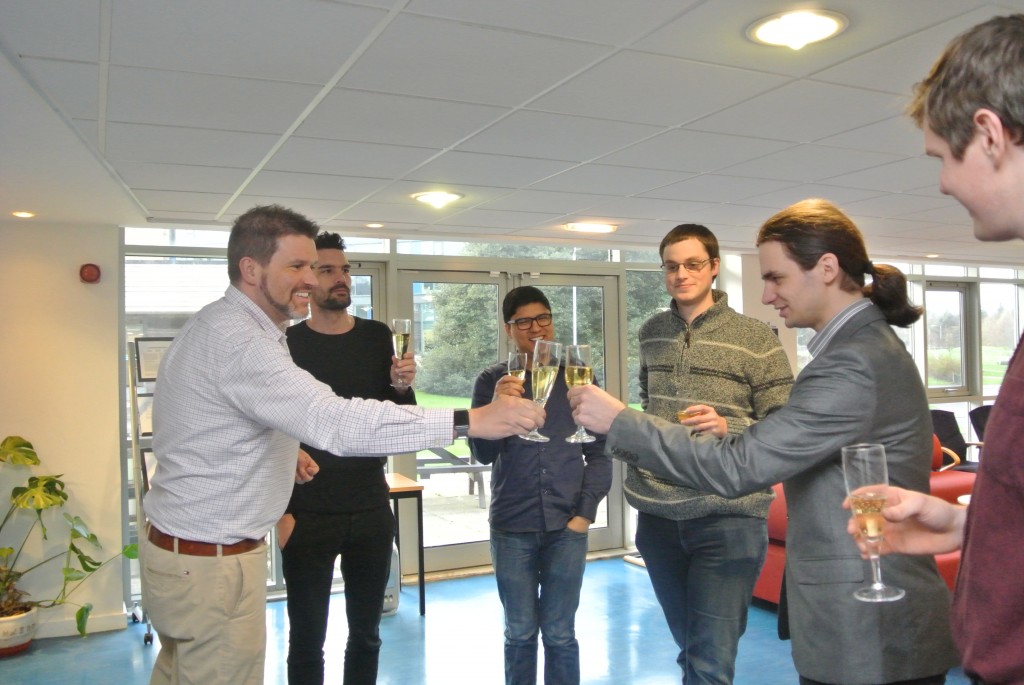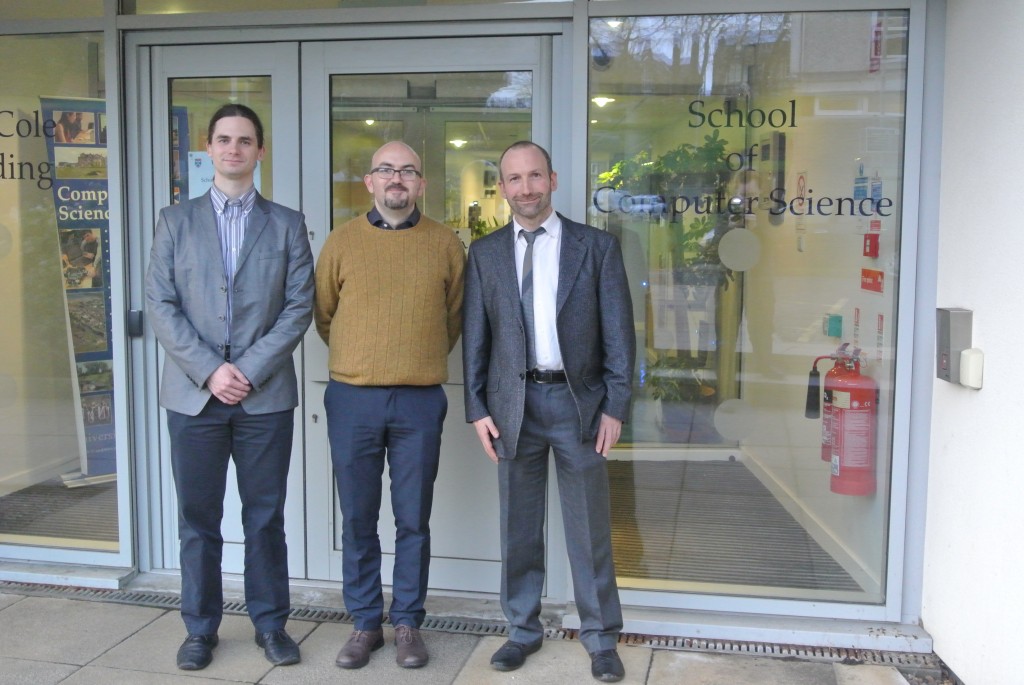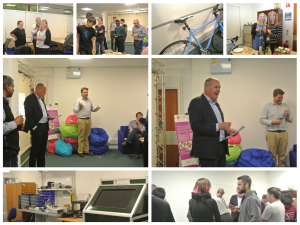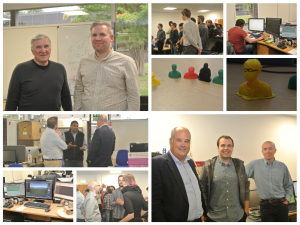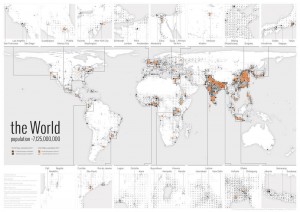Belated congratulations to Michael Mauderer, who successfully defended his thesis earlier this month. Micheal’s thesis, augmenting visual perception with gaze-contigent displays, was supervised by Dr Miguel Nacenta. Professor Aaron Quigley acted as internal examiner and Professor Hans Gellersen, from Lancaster University acted as external examiner.
SACHI
David Harris-Birtill: Converge Challenge Winner 2016
Congratulations to Dr David Harris-Birtill, who was announced the winner of the Converge Challenge KickStart award at a ceremony in Edinburgh yesterday. The converge challenge competition rewards an early-stage idea or a new product. David won a cash injection prize of £3,000 to kick-start Beyond Medics – Automated Remote Pulse Oximetry, a camera based system that remotely measures patients’ vital signs.
PhD Viva Success: Jakub Dostal
Congratulations to Jakub Dostal, who successfully defended his thesis today. He is pictured below celebrating with supervisor Professor Aaron Quigley, internal examiner Dr Miguel Nacenta and external examiner Dr Keith Cheverst from the University of Lancaster.
Official Opening: Interaction Lab
Dean of Science, Professor Al Dearle officially opened the new Interaction Lab earlier today. The lab is situated within the John Honey building within the School of Computer Science and houses the research talents of both SACHI and Open Virtual Worlds.
The Dean of Science, Professor Aaron Quigley Chair of HCI, current staff and students, alumni and Emeritus Professor, Ron Morrison were photographed enjoying the opening celebrations.
LitLong launches from AHRC funded project
The Palimpsest project involving the University of St Andrews’ SACHI group collaborating with the University of Edinburgh’s English literature and text-mining group launched LitLong Edinburgh on 30th march 2015.
 Lit Long: Edinburgh features a range of maps and accessible visualisations, which enable users to interact with Edinburgh’s literature in a variety of ways, exploring the spatial relations of the literary city at particular times in its history, in the works of particular authors, or across different eras, genres and writers. Lit Long: Edinburgh makes a major contribution to our knowledge of the Edinburgh literary cityscape, with potential to shape the experience and understanding of critics and editors, residents and visitors, readers and writers.
Lit Long: Edinburgh features a range of maps and accessible visualisations, which enable users to interact with Edinburgh’s literature in a variety of ways, exploring the spatial relations of the literary city at particular times in its history, in the works of particular authors, or across different eras, genres and writers. Lit Long: Edinburgh makes a major contribution to our knowledge of the Edinburgh literary cityscape, with potential to shape the experience and understanding of critics and editors, residents and visitors, readers and writers.
Give the web visualisation a try here.
SACHI’s Dr Uta Hinrichs created the web visualisation, Dr David Harris-Birtill created the mobile app and Professor Aaron Quigley was the St Andrews lead and co-investigator on the Palimpsest project funded by the AHRC.
This work is featured on the Guardians website and mentioned in Edinburgh University’s news.
April 13th, seminar by Nicolai Marquardt: Towards Ad-hoc Collaboration Spaces with Cross-Device Interaction Techniques
Speaker: Nicolai Marquardt, University College London
Date/Time: 1-2pm April 13, 2015
Location: CS1.33a, University of St Andrews
Abstract:
Despite the ongoing proliferation of devices and form-factors such as tablets and electronic whiteboards, technology often hinders (rather than helps) informal small-group interactions. Whereas natural human conversation is fluid and dynamic, discussions that rely on digital content—slides, documents, clippings—often remain hindered due to the awkwardness of manipulating, sharing, and displaying information on and across multiple devices. Addressing these shortcomings, in this talk I present our research towards fluid, ad-hoc, minimally disruptive techniques for co-located collaboration by leveraging the proxemics of people as well as the proxemics of devices. In particular, I will demonstrate a number of cross-device interaction techniques—situated within the research theme of proxemic interactions—that support nuanced gradations of sharing. I will also introduce different novel hybrid sensing approaches enabling these interaction techniques and discuss future research directions.
Bio:
Nicolai Marquardt is Lecturer in Physical Computing at University College London. At the UCL Interaction Centre he is working in the research areas of ubiquitous computing, physical user interfaces, proxemic interactions, and interactive surfaces. He is co-author of the books Proxemic Interactions: From Theory to Practice (Morgan & Claypool 2015) and Sketching User Experiences: The Workbook (Elsevier, Morgan Kaufmann 2012).
This seminar is part of our ongoing series from researchers in HCI. See here for our current schedule.
Following on from Nicolai Marquardt’s successful talk his slides can now be viewed here: St Andrews guest lecture Nicolai Marquardt – Slide Presentation
Event details
- When: 13th April 2015 13:00 - 14:00
- Where: Cole 1.33a
- Format: Seminar
FatFonts and a World Population Map
Looking for an unusual Christmas gift? Look no further, the first ever FatFonts World Population Map is now available in the Axis Maps store. All proceeds from the maps will fund more research and help us provide exciting internships for students.
Created by Miguel Nacenta and Uta Hinrichs, the map shows how the population of the world is distributed. It uses a typographic visualization technique – FatFonts which allows you to read the exact number of people living in a particular area with a precision within 100,000 people. View the gallery of lytro pictures for further images.
FatFonts are also available to download and use, or for the more inspired, try creating your own.
Although a quirky idea, FatFonts seem to have a bunch of usages… for example, they are convenient when you want to provide a table of numbers that is also a graphical representation. This allows the viewer (or the reader) to very quickly capture the overall distribution, but also to go in and read the specific number, which they can then use to compare to other numbers (in the FatFonts table or in their heads).
FatFonts are great in maps, and that is why Uta and I set out to create a poster that would give a picture of one of the most pressing issues of our time: world population. Thanks to SICSA (and our wonderful helpers Carson, Jed, and Michael), we got the time, money and support to develop the idea. The result is a poster that represents the population of the world using FatFonts. – Miguel Nacenta
Read more about the World Map and FatFonts on Miguel’s blog, the SACHI blog and at FatFonts.
Thursday Seminar from Japan – Prof. Yoshifumi Kitamura – Interactive Content Design and 3D Interactions
Date: 2014-11-13
Time: 14:00 to 15:00
Location: Maths Lecture Theatre A, North Haugh, University of St Andrews.
Title: Interactive Content Design and 3D Interactions
Abstract: Good media content has the power to enrich our lives. We focus on non-traditional content other than movies, music and games, conducting comprehensive research on a variety of interactive content which creates new value through interactions with humans. In this talk I will introduce a series of my group’s recent research projects involving technologies for interactive content design and 3D interactions.
Web: http://www.icd.riec.tohoku.ac.jp/index-e.html
Bio: Yoshifumi Kitamura is a Professor at Research Institute of Electrical Communication, Tohoku University. He received the B.Sc., M.Sc. and PhD. degrees in Engineering from Osaka University in 1985, 1987 and 1996, respectively. Prior to Tohoku University, he was an Associate Professor at Graduate School of Engineering and Graduate School of Information Science and Technology, Osaka University (1997-2010), and before that he was a researcher at ATR Communication Systems Research Laboratories (1992-1996) and Canon Inc. (1987-1992).
Event details
- When: 13th November 2014 14:00 - 15:00
- Where: Maths Theatre A
- Format: Seminar, Symposium, Talk
Ae Fond Farewell: Per Ola Kristensson
As we start a new semester, we take time to reflect on those moving on to new ventures and wish colleague and friend, Per Ola Kristensson every success in his new post in the Department of Engineering at the University of Cambridge.
During his time in the School he had many successes and viewed St Andrews as an “incredibly stimulating and vivid research environment.”
Describing the School and SACHI as “friendly and supportive” he underlined the school’s commitment to ensuring teaching and research is of “the highest calibre.”
Describing the students he worked with as “fantastic” and a pleasure to supervise, he explained that some of their dissertations had lead to scientific publications.
His final reflection:
Looking back, these years I have spent in St Andrews have helped me develop as a researcher and a teacher and I will remember my years here fondly.
We wish him continued success and look forward to seeing him in the very near future. You can read more about his research on the SACHI blog.
SACHI Seminar: Team-buddy: investigating a long-lived robot companion
SACHI seminar
Title: Team-buddy: investigating a long-lived robot companion
Speaker: Ruth Aylett, Heriot-Watt University, Edinburgh
Abstract:
In the EU-funded LIREC project, finishing last year, Heriot-Watt University investigated how a long-lived multi-embodied (robot, graphical) companion might be incorporated into a work-environment as a team buddy, running a final continuous three-week study. This talk gives an overview of the technology issues and some of the surprises from various user-studies.
Bio:
Ruth Aylett is Professor of Computer Sciences in the School of Mathematical and Computer Science at Heriot-Watt University. She researches intelligent graphical characters, affective agent models, human-robot interaction, and interactive narrative. She was a founder of the International Conference on Intelligent Virtual Agents and was a partner in the large HRI project LIREC – see lirec.eu. She has more than 200 publications – book chapters, journals, and refereed conferences and coordinates the Autonomous affective Agents group at Heriot-Watt University- see here
Event details
- When: 10th September 2013 13:00 - 14:00
- Where: Cole 1.33a
- Format: Seminar




